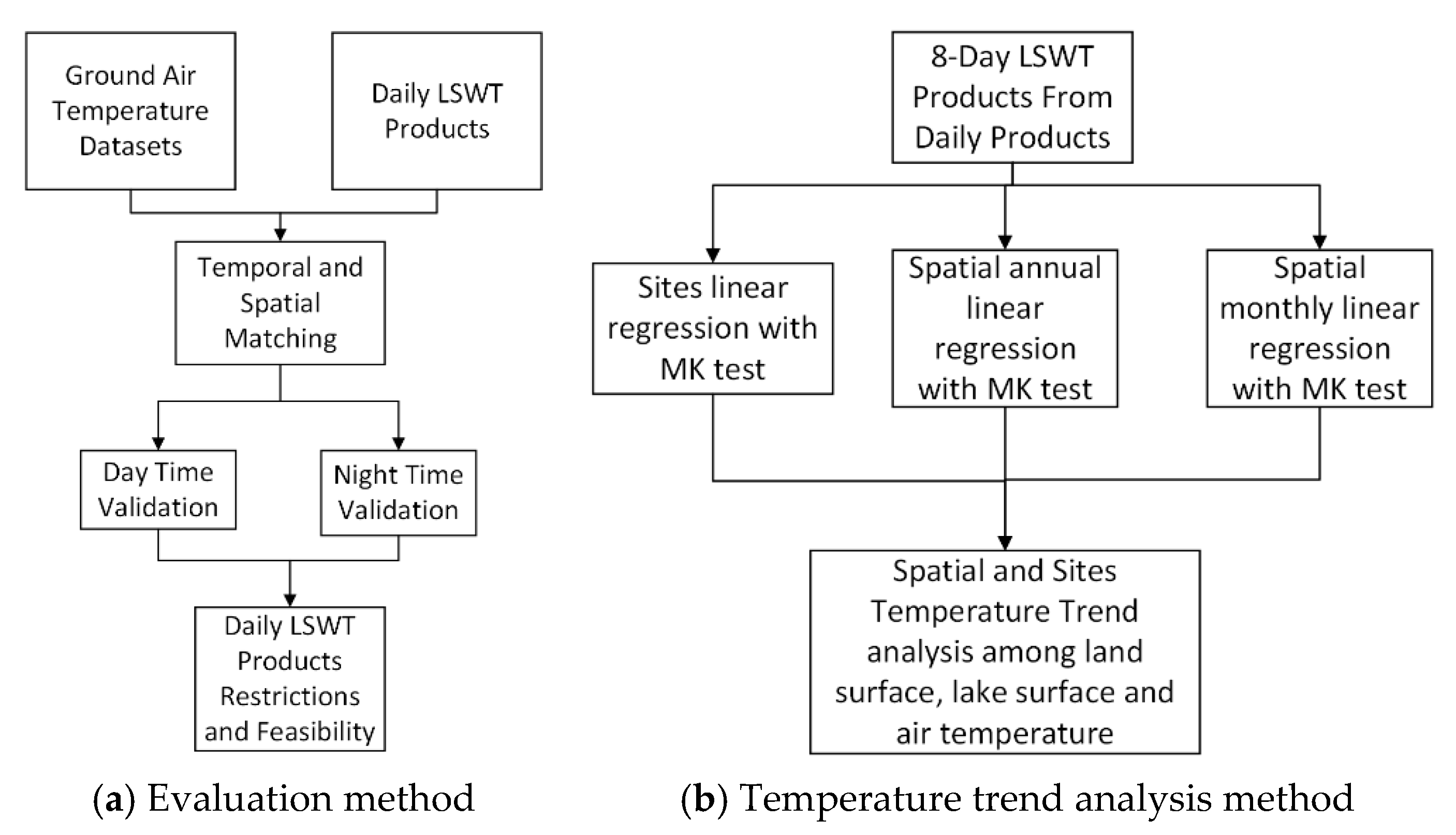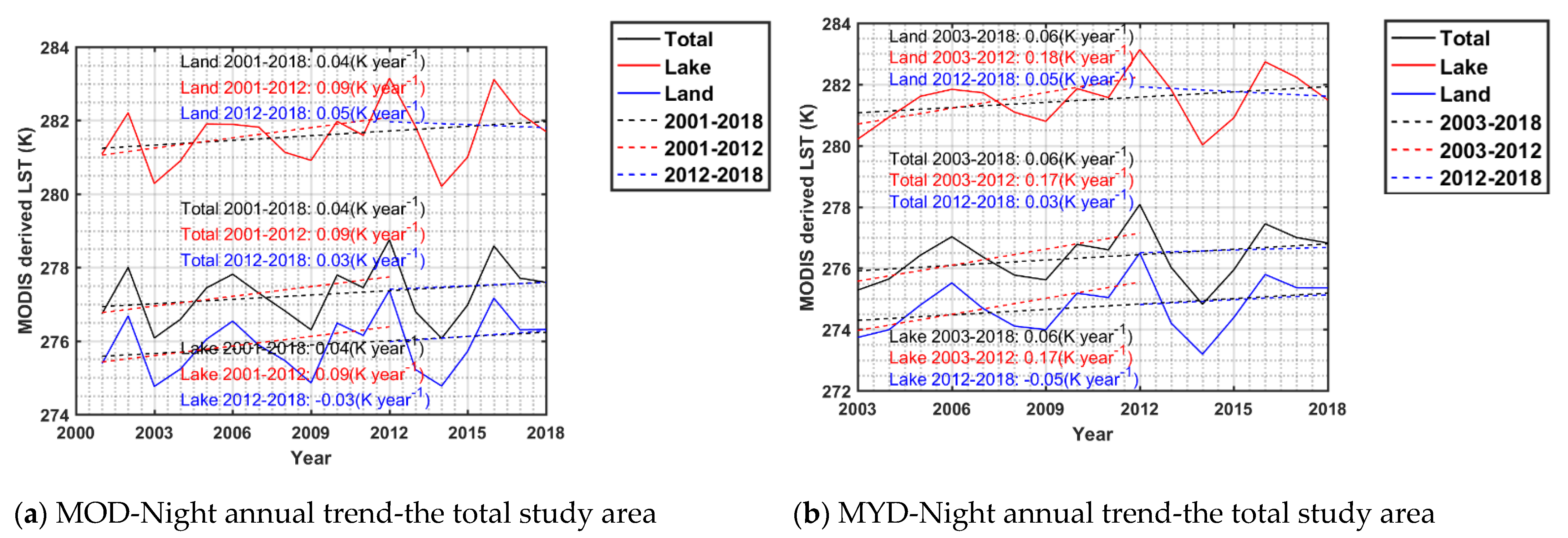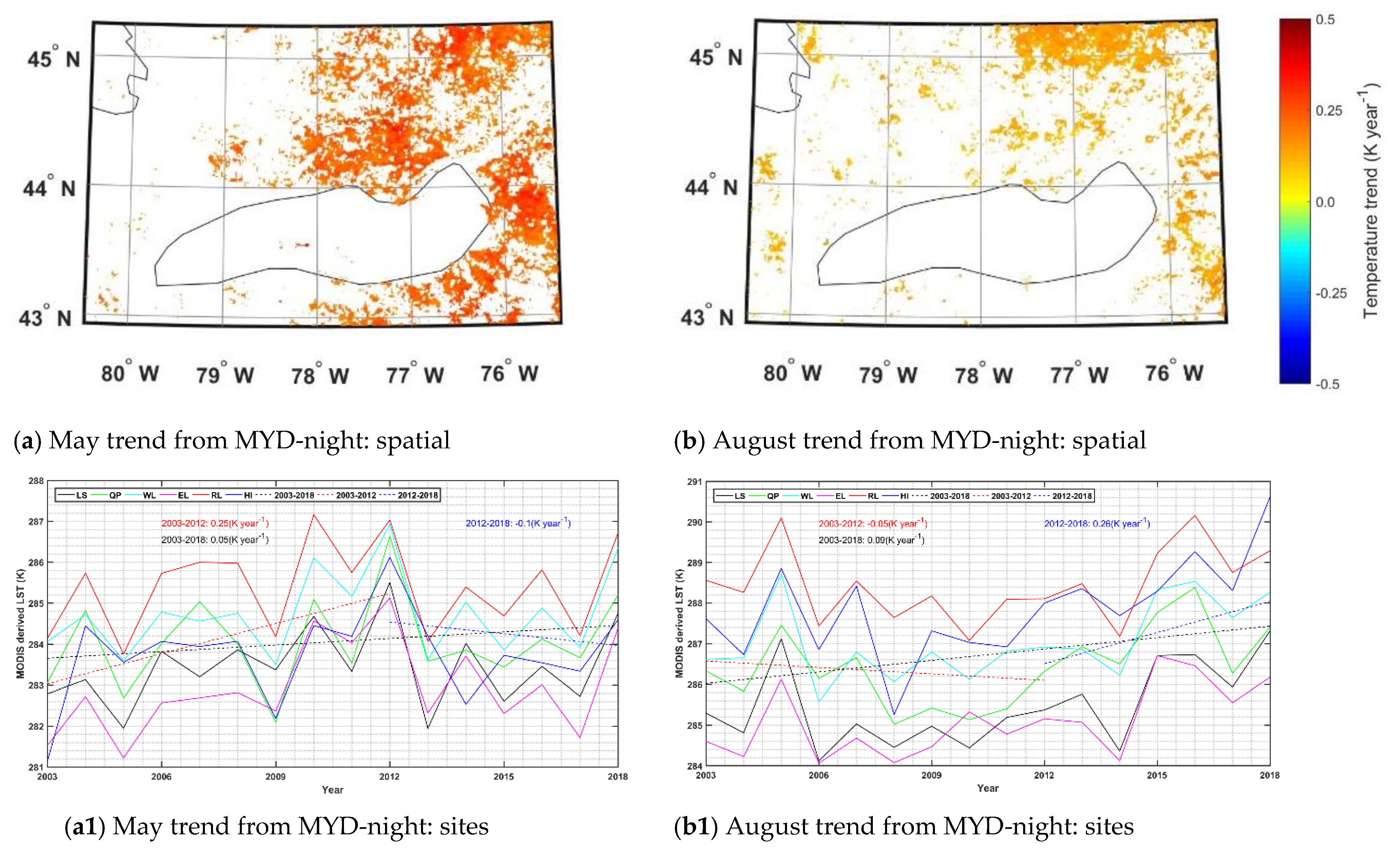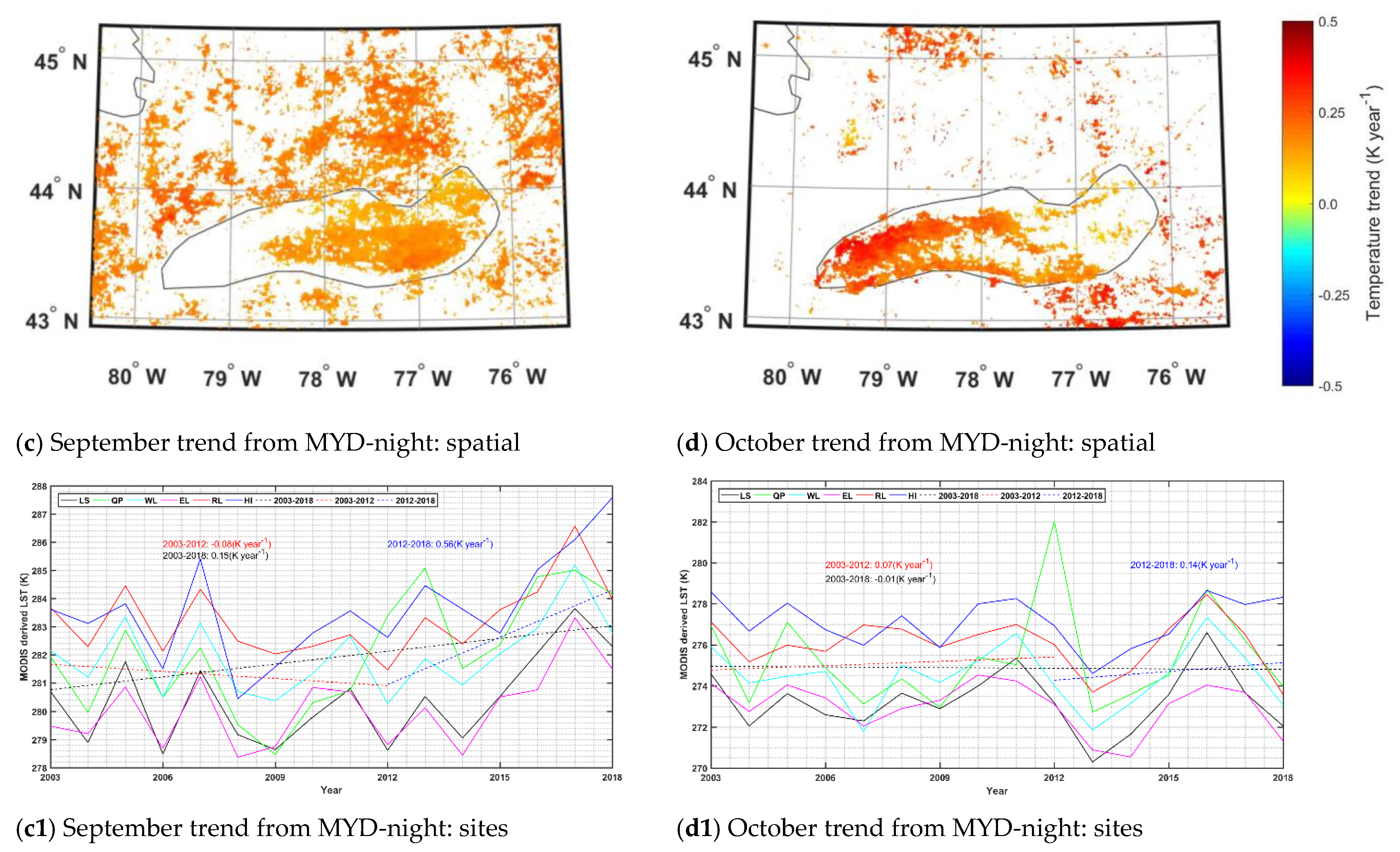A Slight Temperature Warming Trend Occurred over Lake Ontario from 2001 to 2018
Abstract
:1. Introduction
2. Study Area and Data
2.1. Study Area
2.2. MODIS Datasets
2.3. Ground Air Temperature Datasets
3. Methods
3.1. Evaluation of MODIS Products with an In Situ Dataset
3.2. Monthly Temperature Trends Analysis from the MODIS Product
3.3. Mann–Kendall (MK) Test
4. Results
4.1. Evaluation Results of MODIS Products with In Situ Datasets
4.2. Temperature Trends Found by Linear Regression at Six Ground Sites from MODIS Datasets
4.3. Spatial Patterns of Annual Temperature Trend Found by Linear Regression from MODIS Datasets
4.4. Spatial Patterns of Monthly Temperature Trend via Linear Regression from MODIS Datasets
5. Discussion
5.1. The Relationship between LSWT and Air Temperature
5.2. The Similar Results from Other Lakes
5.3. The Possibilities for and Challenges of the MODIS Products in Lake Temperature Trend Analysis
6. Conclusions
Author Contributions
Funding
Institutional Review Board Statement
Informed Consent Statement
Data Availability Statement
Acknowledgments
Conflicts of Interest
Abbreviations
| a.m. | Ante Meridiem |
| AppEEARS | Application for Extracting and Exploring Analysis Ready Samples |
| EL | Elbow Lake |
| GTA | Greater Toronto Area |
| HI | Hill Island |
| IGBP | International Geosphere-Biosphere Program |
| IPCC | Intergovernmental Panel on Climate Change |
| LS | Leroi Swamp |
| LST | Land Surface Temperature |
| LSWT | Lake Surface Water Temperature |
| MCD12Q1 | MODIS/Terra + Aqua Land Cover Type Yearly L3 Global 500 m SIN Grid |
| MK | Mann–Kendall |
| MOD11A1/MOD | MODIS/Terra Land Surface Temperature/Emissivity Daily L3 Global 1km SIN Grid |
| MODIS | Moderate Resolution Imaging Spectroradiometer |
| MYD11A1/MYD | MODIS/Aqua Land Surface Temperature/Emissivity Daily L3 Global 1km SIN Grid |
| p.m. | Post Meridiem |
| QP | Queen’s Point |
| QUBS | Queen’s University Biological Station |
| RL | Round Lake |
| RMSD | Centered Root Mean Square Difference |
| SD | Standard Deviation |
| SQMK | Sequential Mann–Kendall |
| WL | Warner Lake |
References
- Adrian, R.; O’Reilly, C.M.; Zagarese, H.; Baines, S.B.; Hessen, D.O.; Keller, W.; Livingstone, D.M.; Sommaruga, R.; Straile, D.; Van Donk, E. Lakes as sentinels of climate change. Limnol. Oceanogr. 2009, 54, 2283–2297. [Google Scholar] [CrossRef] [PubMed]
- Li, Z.L.; Tang, B.H.; Wu, H.; Ren, H.Z.; Yan, G.J.; Wan, Z.M.; Trigo, I.F.; Sobrino, J.A. Satellite-derived land surface temperature: Current status and perspectives. Remote Sens. Environ. 2013, 131, 14–37. [Google Scholar] [CrossRef] [Green Version]
- Williamson, C.E.; Saros, J.E.; Vincent, W.F.; Smol, J.P. Lakes and reservoirs as sentinels, integrators, and regulators of climate change. Limnol. Oceanogr. 2009, 54, 2273–2282. [Google Scholar] [CrossRef]
- Pivato, M.; Carniello, L.; Viero, D.P.; Soranzo, C.; Defina, A.; Silvestri, S. Remote sensing for optimal estimation of water temperature dynamics in shallow tidal environments. Remote Sens. 2020, 12, 51. [Google Scholar] [CrossRef] [Green Version]
- Guo, L.; Zheng, H.; Wu, Y.; Zhang, T.; Zhang, B. Responses of Lake Ice Phenology to Climate Change at Tibetan Plateau. IEEE J. Sel. Top. Appl. Earth Obs. Remote Sens. 2020, 13, 3856–3861. [Google Scholar] [CrossRef]
- Dörnhöfer, K.; Oppelt, N. Remote sensing for lake research and monitoring–Recent advances. Ecol. Indic. 2016, 64, 105–122. [Google Scholar] [CrossRef]
- Good, E. Daily minimum and maximum surface air temperatures from geostationary satellite data. J. Geophys. Res. Atmos. 2015, 120, 2306–2324. [Google Scholar] [CrossRef]
- Wan, Z. MODIS Land-Surface Temperature Algorithm Theoretical Basis Document (LST ATBD); Institute for Computational Earth System Science University of California: Santa Barbara, CA, USA, 1999. [Google Scholar]
- Stocker, T.F.; Qin, D.; Plattner, G.-K.; Tignor, M.; Allen, S.K.; Boschung, J.; Nauels, A.; Xia, Y.; Bex, V.; Midgley, P.M. The Physical Science Basis. Contribution of Working Group I to the Fifth Assessment Report of the Intergovernmental Panel on Climate Change. 2013; Cambridge University Press: Cambridge, UK; New York, NY, USA, 2013; pp. 33–118. [Google Scholar]
- Wang, X.; Xiao, J.; Li, X.; Cheng, G.; Ma, M.; Zhu, G.; Arain, M.A.; Black, T.A.; Jassal, R.S. No trends in spring and autumn phenology during the global warming hiatus. Nat. Commun. 2019, 10, 2389. [Google Scholar] [CrossRef]
- Medhaug, I.; Stolpe, M.B.; Fischer, E.M.; Knutti, R. Reconciling controversies about the ‘global warming hiatus’. Nature 2017, 545, 41–47. [Google Scholar] [CrossRef]
- Fyfe, J.C.; Meehl, G.A.; England, M.H.; Mann, M.E.; Santer, B.D.; Flato, G.M.; Hawkins, E.; Gillett, N.P.; Xie, S.-P.; Kosaka, Y. Making sense of the early-2000s warming slowdown. Nat. Clim. Chang. 2016, 6, 224–228. [Google Scholar] [CrossRef] [Green Version]
- Fyfe, J.C.; Gillett, N.P.; Zwiers, F.W. Overestimated global warming over the past 20 years. Nat. Clim. Chang. 2013, 3, 767–769. [Google Scholar] [CrossRef]
- An, W.; Hou, S.; Hu, Y.; Wu, S. Delayed warming hiatus over the Tibetan Plateau. Earth Space Sci. 2017, 4, 128–137. [Google Scholar] [CrossRef]
- Li, L.; Zha, Y. Satellite-based regional warming hiatus in China and its implication. Sci. Total Environ. 2019, 648, 1394–1402. [Google Scholar] [CrossRef]
- Ouyang, X.; Chen, D.; Feng, Y.; Lei, Y. Comparison of seasonal surface temperature trend, spatial variability, and elevation dependency from satellite-derived products and numerical simulations over the Tibetan Plateau from 2003 to 2011. Int. J. Remote Sens. 2019, 40, 1844–1857. [Google Scholar] [CrossRef]
- Cheng, L.; Abraham, J.; Hausfather, Z.; Trenberth, K.E. How fast are the oceans warming? Science 2019, 363, 128–129. [Google Scholar] [CrossRef]
- Parida, B.R.; Oinam, B.; Patel, N.R.; Sharma, N.; Kandwal, R.; Hazarika, M.K. Land surface temperature variation in relation to vegetation type using MODIS satellite data in Gujarat state of India. Int. J. Remote Sens. 2008, 29, 4219–4235. [Google Scholar] [CrossRef]
- Jin, M.; Dickinson, R.E. Land surface skin temperature climatology: Benefitting from the strengths of satellite observations. Environ. Res. Lett. 2010, 5, 044004. [Google Scholar] [CrossRef] [Green Version]
- Zhang, P.; Bounoua, L.; Imhoff, M.L.; Wolfe, R.E.; Thome, K. Comparison of MODIS Land Surface Temperature and Air Temperature over the Continental USA Meteorological Stations. Can. J. Remote Sens. 2014, 40, 110–122. [Google Scholar]
- Mutiibwa, D.; Strachan, S.; Albright, T. Land Surface Temperature and Surface Air Temperature in Complex Terrain. IEEE J. Sel. Top. Appl. Earth Obs. Remote Sens. 2015, 8, 4762–4774. [Google Scholar] [CrossRef]
- Ouyang, X.; Chen, D.; Lei, Y. A Generalized Evaluation Scheme for Comparing Temperature Products from Satellite Observations, Numerical Weather Model, and Ground Measurements Over the Tibetan Plateau. IEEE Trans. Geosci. Remote Sens. 2018, 56, 3876–3894. [Google Scholar] [CrossRef]
- Botts, L.; Krushelnicki, B. The Great Lakes. An Environmental Atlas and Resource Book; ERIC: Washington, DC, USA, 1987. [Google Scholar]
- Céleste Irambona, B.M. David Huard, Anne Frigon. In Lake Ontario Water Temperature in a Changing Climate; Report Presented to Ontario Power GEneration; Ouranos: Montreal, QC, Canada, 2017. [Google Scholar]
- Nalley, D.; Adamowski, J.; Khalil, B.; Ozga-Zielinski, B. Trend detection in surface air temperature in Ontario and Quebec, Canada during 1967–2006 using the discrete wavelet transform. Atmos. Res. 2013, 132, 375–398. [Google Scholar] [CrossRef]
- Mohsin, T.; Gough, W.A. Trend analysis of long-term temperature time series in the Greater Toronto Area (GTA). Theor. Appl. Climatol. 2010, 101, 311–327. [Google Scholar] [CrossRef]
- Ghaderpour, E.; Vujadinovic, T.; Hassan, Q.K. Application of the least-squares wavelet software in hydrology: Athabasca River basin. J. Hydrol. Reg. Stud. 2021, 36, 100847. [Google Scholar] [CrossRef]
- Masud, M.B.; Ferdous, J.; Faramarzi, M. Projected changes in hydrological variables in the agricultural region of Alberta, Canada. Water 2018, 10, 1810. [Google Scholar] [CrossRef] [Green Version]
- Merritt, W.S.; Alila, Y.; Barton, M.; Taylor, B.; Cohen, S.; Neilsen, D. Hydrologic response to scenarios of climate change in sub watersheds of the Okanagan basin, British Columbia. J. Hydrol. 2006, 326, 79–108. [Google Scholar] [CrossRef]
- Coll, C.; Caselles, V.; Galve, J.M.; Valor, E.; Niclos, R.; Sánchez, J.M.; Rivas, R. Ground measurements for the validation of land surface temperatures derived from AATSR and MODIS data. Remote Sens. Environ. 2005, 97, 288–300. [Google Scholar] [CrossRef]
- Sohrabinia, M.; Rack, W.; Zawar-Reza, P. Analysis of MODIS LST compared with WRF model and in situ data over the Waimakariri River basin, Canterbury, New Zealand. Remote Sens. 2012, 4, 3501–3527. [Google Scholar] [CrossRef] [Green Version]
- Ren, H.; Yan, G.; Chen, L.; Li, Z. Angular effect of MODIS emissivity products and its application to the split-window algorithm. ISPRS J. Photogramm. Remote Sens. 2011, 66, 498–507. [Google Scholar] [CrossRef]
- Duan, S.-B.; Li, Z.-L.; Cheng, J.; Leng, P. Cross-satellite comparison of operational land surface temperature products derived from MODIS and ASTER data over bare soil surfaces. ISPRS J. Photogramm. Remote Sens. 2017, 126, 1–10. [Google Scholar] [CrossRef]
- Duan, Z.; Bastiaanssen, W. A new empirical procedure for estimating intra-annual heat storage changes in lakes and reservoirs: Review and analysis of 22 lakes. Remote Sens. Environ. 2015, 156, 143–156. [Google Scholar] [CrossRef]
- Lofgren, B.M.; Zhu, Y. Surface energy fluxes on the Great Lakes based on satellite-observed surface temperatures 1992 to 1995. J. Great Lakes Res. 2000, 26, 305–314. [Google Scholar] [CrossRef]
- Cheng, J.; Cheng, X.; Meng, X.; Zhou, G. A Monte Carlo Emissivity Model for Wind-Roughened Sea Surface. Sensors 2019, 19, 2166. [Google Scholar] [CrossRef] [PubMed] [Green Version]
- Chatterjee, S.; Bisai, D.; Khan, A. Detection of approximate potential trend turning points in temperature time series (1941–2010) for Asansol weather observation station, West Bengal, India. Atmos. Clim. Sci. 2013, 2014. [Google Scholar] [CrossRef] [Green Version]
- Liu, Y.; Yue, T.; Jiao, Y.; Zhao, N.; Zhao, M. Temperature changes in the Heihe River Basin based on high accuracy surface modelling. Meteorol. Appl. 2019, 26, 720–732. [Google Scholar] [CrossRef]
- Zhao, W.; He, J.; Yin, G.; Wen, F.; Wu, H. Spatiotemporal Variability in Land Surface Temperature Over the Mountainous Region Affected by the 2008 Wenchuan Earthquake From 2000 to 2017. J. Geophys. Res. Atmos. 2019, 124, 1975–1991. [Google Scholar] [CrossRef]
- Zhang, G.Q.; Yao, T.D.; Xie, H.J.; Qin, J.; Ye, Q.H.; Dai, Y.F.; Guo, R.F. Estimating surface temperature changes of lakes in the Tibetan Plateau using MODIS LST data. J. Geophys. Res. Atmos. 2014, 119, 8552–8567. [Google Scholar] [CrossRef]
- Wan, W.; Zhao, L.; Xie, H.; Liu, B.; Li, H.; Cui, Y.; Ma, Y.; Hong, Y. Lake surface water temperature change over the Tibetan plateau from 2001 to 2015: A sensitive indicator of the warming climate. Geophys. Res. Lett. 2018, 45, 11–177. [Google Scholar] [CrossRef]
- Song, K.; Wang, M.; Du, J.; Yuan, Y.; Ma, J.; Wang, M.; Mu, G. Spatiotemporal variations of lake surface temperature across the Tibetan Plateau using MODIS LST product. Remote Sens. 2016, 8, 854. [Google Scholar] [CrossRef] [Green Version]
- Hulley, G.C.; Hook, S.J.; Schneider, P. Optimized split-window coefficients for deriving surface temperatures from inland water bodies. Remote Sens. Environ. 2011, 115, 3758–3769. [Google Scholar] [CrossRef]
- Toffolon, M.; Piccolroaz, S.; Majone, B.; Soja, A.M.; Peeters, F.; Schmid, M.; Wüest, A. Prediction of surface temperature in lakes with different morphology using air temperature. Limnol. Oceanogr. 2014, 59, 2185–2202. [Google Scholar] [CrossRef] [Green Version]
- Jeppesen, E.; Beklioğlu, M.; Özkan, K.; Akyürek, Z. Salinization increase due to climate change will have substantial negative effects on inland waters: A call for multifaceted research at the local and global scale. Innovation 2020, 1. [Google Scholar] [CrossRef] [PubMed]
- Zhao, W.; Duan, S.-B. Reconstruction of daytime land surface temperatures under cloud-covered conditions using integrated MODIS/Terra land products and MSG geostationary satellite data. Remote Sens. Environ. 2020, 247, 111931. [Google Scholar] [CrossRef]








| Site Name | Longitude | Latitude | Land Cover * | Temporal Range | Code | ||
|---|---|---|---|---|---|---|---|
| 2015 | 2016 | 2017 | |||||
| Leroi Swamp | 76.37° W | 44.55° N | deciduous broadleaf | 02.28–09.01 | 02.29–09.01 | 02.28–09.01 | LS |
| Queen’s Point | 76.32° W | 44.56° N | woody savannas/water bodies | 04.13–09.01 | 02.29–09.01 | 02.28–09.01 | QP |
| Warner Lake | 76.38° W | 44.52° N | woody savannas | 02.28–09.01 | 02.29–09.01 | 02.28–09.01 | WL |
| Elbow Lake | 76.42° W | 44.47° N | water bodies | 04.07–09.01 | 02.29–09.01 | 02.28–09.01 | EL |
| Round Lake | 76.40° W | 44.54° N | deciduous broadleaf/woody savannas | 02.28–09.01 | 02.29–09.01 | 02.28–09.01 | RL |
| Hill Island | 75.95° W | 44.37° N | woody savannas | None | 06.20–09.01 | 02.28–09.01 | HI |
| Product | Code | SDg (K) | RMSD (K) | Correlation | |
|---|---|---|---|---|---|
| MOD-day time | LS | 291.85 | 9.44 | 3.07 | 0.95 |
| QP | 295.08 | 5.47 | 2.31 | 0.91 | |
| WL | 292.11 | 8.42 | 3.17 | 0.93 | |
| EL | 291.30 | 7.11 | 3.47 | 0.88 | |
| RL | 291.15 | 8.97 | 2.84 | 0.95 | |
| HI | 296.69 | 3.86 | 1.88 | 0.88 | |
| MOD-nighttime | LS | 284.34 | 8.03 | 3.21 | 0.92 |
| QP | 288.92 | 5.74 | 2.20 | 0.93 | |
| WL | 286.70 | 6.53 | 2.54 | 0.93 | |
| EL | 286.19 | 6.56 | 3.55 | 0.86 | |
| RL | 285.75 | 7.62 | 2.51 | 0.95 | |
| HI | 291.94 | 5.66 | 1.88 | 0.95 | |
| MYD-day time | LS | 292.53 | 7.68 | 4.41 | 0.82 |
| QP | 294.43 | 7.03 | 3.60 | 0.87 | |
| WL | 293.08 | 6.52 | 2.92 | 0.90 | |
| EL | 293.72 | 6.73 | 3.56 | 0.85 | |
| RL | 294.73 | 7.22 | 3.80 | 0.85 | |
| HI | 297.10 | 4.26 | 1.92 | 0.90 | |
| MYD-nighttime | LS | 286.09 | 6.58 | 1.48 | 0.97 |
| QP | 286.85 | 5.11 | 2.15 | 0.92 | |
| WL | 283.95 | 6.67 | 2.07 | 0.95 | |
| EL | 284.37 | 6.56 | 2.25 | 0.94 | |
| RL | 283.86 | 6.09 | 2.16 | 0.94 | |
| HI | 289.64 | 4.73 | 0.73 | 0.99 |
| Product | Code | Period (2001/2003–2018) | Period (2001/2003–2012) | Period (2012–2018) | Period (2001/2003–2010) | Period (2010–2018) | ||||||||||
|---|---|---|---|---|---|---|---|---|---|---|---|---|---|---|---|---|
| Slope | Intercept | Z Value | Slope | Intercept | Z Value | Slope | Intercept | Z Value | Slope | Intercept | Z Value | Slope | Intercept | Z Value | ||
| MOD-night-time | LS | 0.06 | 274.92 | 1.52 | 0.09 | 274.74 | 1.03 | −0.05 | 276.54 | 0 | 0.02 | 275.07 | 0 | −0.01 | 276.03 | −0.10 |
| QP | 0.05 | 277.34 | 0.08 | 0.14 | 276.97 | 0.07 | −0.11 | 279.98 | 0 | −0.03 | 277.67 | −0.72 | 0.02 | 277.92 | −0.10 | |
| WL | 0.07 | 275.83 | 1.82 | 0.14 | 275.53 | 1.58 | −0.01 | 277.15 | 0.30 | 0.05 | 275.90 | 0.72 | −0.01 | 277.14 | 0.10 | |
| EL | 0.07 | 275.13 | 1.44 | 0.18 | 274.63 | 1.99 | −0.07 | 277.18 | 0 | 0.08 | 275.05 | 1.07 | −0.07 | 277.17 | −0.31 | |
| RL | 0.04 | 276.02 | 1.14 | 0.11 | 275.72 | 1.17 | −0.04 | 277.36 | 0 | 0.06 | 275.94 | 0.18 | −0.04 | 277.27 | −0.10 | |
| HI | 0.06 | 277.64 | 1.52 | 0.09 | 277.57 | 1.17 | 0.09 | 277.29 | 0.60 | −0.07 | 278.21 | −0.18 | 0.04 | 278.08 | 0.52 | |
| MYD-night-time | LS | 0.06 | 273.89 | 1.13 | 0.22 | 273.24 | 1.97 | −0.00 | 274.64 | 0.30 | 0.13 | 273.55 | 1.11 | −0.03 | 275.06 | −0.31 |
| QP | 0.07 | 275.72 | 0.86 | 0.08 | 275.72 | 0 | 0.01 | 276.65 | 0 | −0.09 | 276.33 | −0.62 | 0.11 | 275.25 | 0.73 | |
| WL | 0.07 | 274.96 | 1.04 | 0.18 | 274.55 | 1.97 | 0.14 | 273.90 | 0.30 | 0.11 | 274.82 | 1.11 | 0.02 | 275.56 | 0.10 | |
| EL | 0.05 | 273.85 | 1.22 | 0.24 | 273.04 | 2.50 | −0.02 | 274.62 | 0 | 0.19 | 273.22 | 1.86 | −0.13 | 276.04 | −0.73 | |
| RL | 0.04 | 275.95 | 0.77 | 0.19 | 275.37 | 2.15 | 0.08 | 275.39 | 0.30 | 0.17 | 275.50 | 1.36 | −0.03 | 276.84 | 0.10 | |
| HI | 0.06 | 276.72 | 0.95 | 0.15 | 276.72 | 0.89 | −0.01 | 276.32 | 0 | 0.18 | 276.28 | 0.62 | 0.02 | 277.13 | 0.10 | |
Publisher’s Note: MDPI stays neutral with regard to jurisdictional claims in published maps and institutional affiliations. |
© 2021 by the authors. Licensee MDPI, Basel, Switzerland. This article is an open access article distributed under the terms and conditions of the Creative Commons Attribution (CC BY) license (https://creativecommons.org/licenses/by/4.0/).
Share and Cite
Ouyang, X.; Chen, D.; Zhou, S.; Zhang, R.; Yang, J.; Hu, G.; Dou, Y.; Liu, Q. A Slight Temperature Warming Trend Occurred over Lake Ontario from 2001 to 2018. Land 2021, 10, 1315. https://doi.org/10.3390/land10121315
Ouyang X, Chen D, Zhou S, Zhang R, Yang J, Hu G, Dou Y, Liu Q. A Slight Temperature Warming Trend Occurred over Lake Ontario from 2001 to 2018. Land. 2021; 10(12):1315. https://doi.org/10.3390/land10121315
Chicago/Turabian StyleOuyang, Xiaoying, Dongmei Chen, Shugui Zhou, Rui Zhang, Jinxin Yang, Guangcheng Hu, Youjun Dou, and Qinhuo Liu. 2021. "A Slight Temperature Warming Trend Occurred over Lake Ontario from 2001 to 2018" Land 10, no. 12: 1315. https://doi.org/10.3390/land10121315
APA StyleOuyang, X., Chen, D., Zhou, S., Zhang, R., Yang, J., Hu, G., Dou, Y., & Liu, Q. (2021). A Slight Temperature Warming Trend Occurred over Lake Ontario from 2001 to 2018. Land, 10(12), 1315. https://doi.org/10.3390/land10121315










